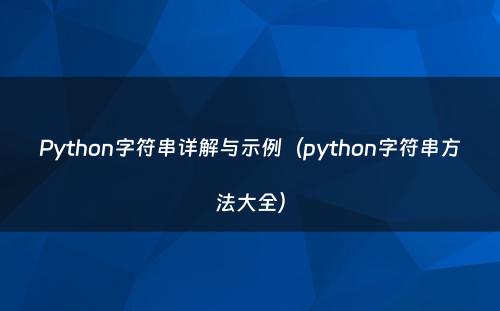网站首页 > java教程 正文
艾瑞巴蒂字符串的干货来了,
字符串是程序中最常见的数据类型之一,用来表示数据文本,下面就来介绍

下字符串的特性,操作和方法,和一些示例来吧道友:
1. 字符串的创建
在python中字符串可以永单引号(' ')双引号(" ")和或三引号(''' '''或""" """)来创建。
# 单引号字符串
str1 = 'Hello, World!'
# 双引号字符串
str2 = "Python Programming"
# 三引号字符串(可以跨多行)
str3 = '''This is a
multi-line
string.'''
print(str1)
print(str2)
print(str3)2. 字符串的基本操作
访问子串串的字符
s = "Python"
print(s[0]) # 输出: 'P' (第一个字符)
print(s[-1]) # 输出: 'n' (最后一个字符)字符串切片(字符提取可以这么理解)
s = "Programming"
print(s[0:4]) # 输出: 'Prog' (索引0到3)
print(s[3:]) # 输出: 'gramming' (从索引3到最后)
print(s[:6]) # 输出: 'Progra' (从开始到索引5)
print(s[-5:-2]) # 输出: 'mmi' (倒数第5到倒数第3)
print(s[::2]) # 输出: 'Pormig' (每隔一个字符)字符串连接(+号链接)
s1 = "Hello"
s2 = "World"
print(s1 + " " + s2) # 输出: 'Hello World'字符串重复(*号后面加重复次数)
s = "Hi"
print(s * 3) # 输出: 'HiHiHi'3. 字符串常用方法
查找方法
s = "Python Programming"
# find() - 返回子字符串的起始索引,找不到返回-1
print(s.find("Pro")) # 输出: 7
print(s.find("Java")) # 输出: -1
# index() - 类似find(),但找不到会抛出异常
print(s.index("Pro")) # 输出: 7
# count() - 统计子字符串出现次数
print(s.count("m")) # 输出: 2修改方法 (大小写,替换)
s = " hello world "
# lower()和upper()
print(s.upper()) # 输出: ' HELLO WORLD '
print(s.lower()) # 输出: ' hello world '
# strip() - 去除两端空白
print(s.strip()) # 输出: 'hello world'
# replace() - 替换子字符串
print(s.replace("world", "Python")) # 输出: ' hello Python '
# split() - 分割字符串
print("apple,banana,orange".split(",")) # 输出: ['apple', 'banana', 'orange']检查方法
s = "Python123"
# isalpha() - 是否全是字母
print(s.isalpha()) # 输出: False
# isdigit() - 是否全是数字
print("123".isdigit()) # 输出: True
# isalnum() - 是否只包含字母和数字
print(s.isalnum()) # 输出: True
# startswith()和endswith()
print(s.startswith("Py")) # 输出: True
print(s.endswith("23")) # 输出: True4. 字符串格式化 三种格式
% 格式化 (旧式)
name = "Alice"
age = 25
print("My name is %s and I'm %d years old." % (name, age))str.format() 方法
name = "Bob"
age = 30
print("My name is {} and I'm {} years old.".format(name, age))
print("My name is {1} and I'm {0} years old.".format(age, name))f-strings (Python 3.6+)
name = "Charlie"
age = 35
print(f"My name is {name} and I'm {age} years old.")
print(f"Next year I'll be {age + 1} years old.")5. 字符串的转义字符
print("Line1\nLine2") # 换行
print("Tab\tseparated") # 制表符
print("This is a backslash: \\") # 反斜杠
print("She said, \"Hello!\"") # 双引号
print('It\'s raining') # 单引号6. 字符串不可变性
字符串是不可变的,意味着不能直接修改字符串中的某个字符
s = "hello"
# s[0] = 'H' # 这会报错
# 正确的方法是创建新字符串
s = 'H' + s[1:]
print(s) # 输出: 'Hello'7. 字符串编码
# 编码为字节
s = "你好"
b = s.encode('utf-8')
print(b) # 输出: b'\xe4\xbd\xa0\xe5\xa5\xbd'
# 解码回字符串
s2 = b.decode('utf-8')
print(s2) # 输出: '你好'8. 字符串其他有用方法
# join() - 连接序列中的字符串
words = ["Python", "is", "great"]
print(" ".join(words)) # 输出: 'Python is great'
# partition() - 分割字符串为三部分
print("python.is.cool".partition(".")) # 输出: ('python', '.', 'is.cool')
# zfill() - 用零填充字符串
print("42".zfill(5)) # 输出: '00042'以上为字符串的常用操作,掌握这基本操作你就张了个翅膀!
多练才是王道,初学着几天不看全忘完!
老板点个赞加收藏呗
猜你喜欢
- 2025-05-08 探索Java世界的新天地:JDK最新特性解读
- 2025-05-08 Java 15 新特性:文本块(java纯文本)
- 2025-05-08 贼好用的 Java 工具类库(java常用工具包)
- 2025-05-08 Java编程学习入门、Java语言学习、Java入门必看
- 2025-05-08 Android关于Groovy语言,你知道哪些?
- 2025-05-08 Java Web开发中常见漏洞及防护(java上传漏洞)
- 2025-05-08 轻量级的数据交换语言——JSON(数据交换和接口调用)
- 2025-05-08 Java程序语言之灵魂一(程序的灵魂算法)
- 2025-05-08 java正则表达式的使用(java正则怎么用)
- 2025-05-08 以后我准备告别String.format()了,因为它不够香!
欢迎 你 发表评论:
- 最近发表
- 标签列表
-
- java反编译工具 (77)
- java反射 (57)
- java接口 (61)
- java随机数 (63)
- java7下载 (59)
- java数据结构 (61)
- java 三目运算符 (65)
- java对象转map (63)
- Java继承 (69)
- java字符串替换 (60)
- 快速排序java (59)
- java并发编程 (58)
- java api文档 (60)
- centos安装java (57)
- java调用webservice接口 (61)
- java深拷贝 (61)
- 工厂模式java (59)
- java代理模式 (59)
- java.lang (57)
- java连接mysql数据库 (67)
- java重载 (68)
- java 循环语句 (66)
- java反序列化 (58)
- java时间函数 (60)
- java是值传递还是引用传递 (62)

本文暂时没有评论,来添加一个吧(●'◡'●)